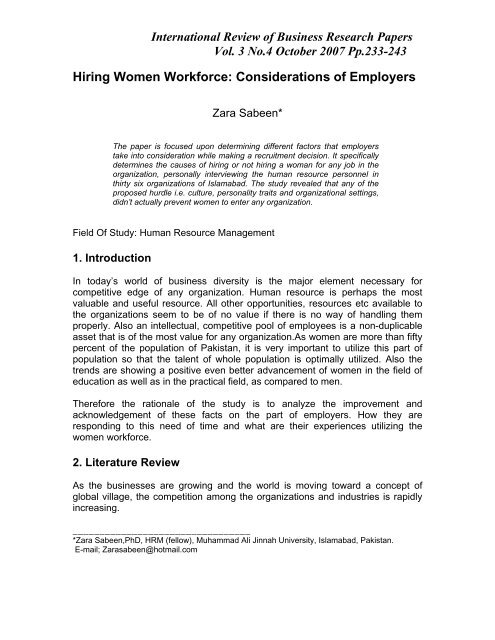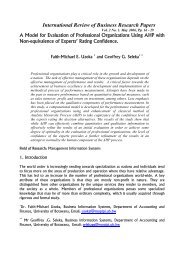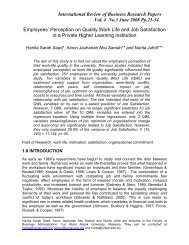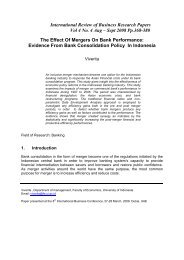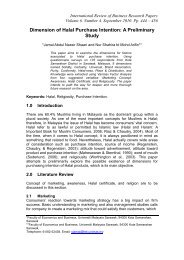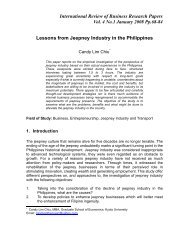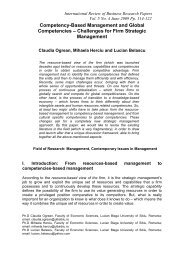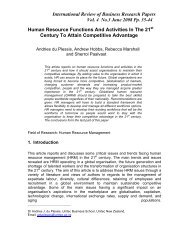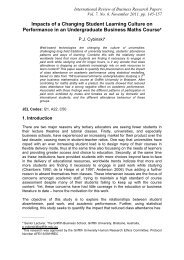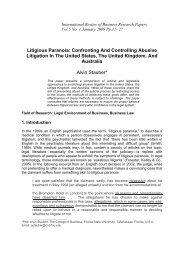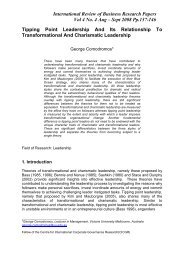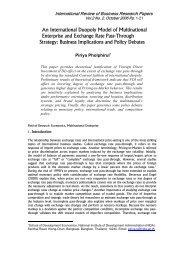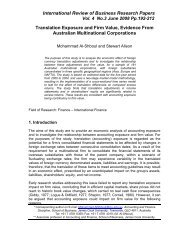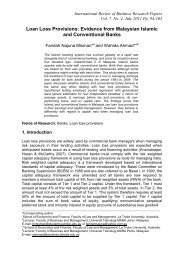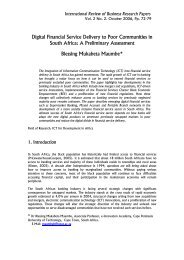Hiring Women Workforce: Considerations of Employers
Hiring Women Workforce: Considerations of Employers
Hiring Women Workforce: Considerations of Employers
Create successful ePaper yourself
Turn your PDF publications into a flip-book with our unique Google optimized e-Paper software.
International Review <strong>of</strong> Business Research Papers<br />
Vol. 3 No.4 October 2007 Pp.233-243<br />
<strong>Hiring</strong> <strong>Women</strong> <strong>Workforce</strong>: <strong>Considerations</strong> <strong>of</strong> <strong>Employers</strong><br />
Zara Sabeen*<br />
The paper is focused upon determining different factors that employers<br />
take into consideration while making a recruitment decision. It specifically<br />
determines the causes <strong>of</strong> hiring or not hiring a woman for any job in the<br />
organization, personally interviewing the human resource personnel in<br />
thirty six organizations <strong>of</strong> Islamabad. The study revealed that any <strong>of</strong> the<br />
proposed hurdle i.e. culture, personality traits and organizational settings,<br />
didn’t actually prevent women to enter any organization.<br />
Field Of Study: Human Resource Management<br />
1. Introduction<br />
In today’s world <strong>of</strong> business diversity is the major element necessary for<br />
competitive edge <strong>of</strong> any organization. Human resource is perhaps the most<br />
valuable and useful resource. All other opportunities, resources etc available to<br />
the organizations seem to be <strong>of</strong> no value if there is no way <strong>of</strong> handling them<br />
properly. Also an intellectual, competitive pool <strong>of</strong> employees is a non-duplicable<br />
asset that is <strong>of</strong> the most value for any organization.As women are more than fifty<br />
percent <strong>of</strong> the population <strong>of</strong> Pakistan, it is very important to utilize this part <strong>of</strong><br />
population so that the talent <strong>of</strong> whole population is optimally utilized. Also the<br />
trends are showing a positive even better advancement <strong>of</strong> women in the field <strong>of</strong><br />
education as well as in the practical field, as compared to men.<br />
Therefore the rationale <strong>of</strong> the study is to analyze the improvement and<br />
acknowledgement <strong>of</strong> these facts on the part <strong>of</strong> employers. How they are<br />
responding to this need <strong>of</strong> time and what are their experiences utilizing the<br />
women workforce.<br />
2. Literature Review<br />
As the businesses are growing and the world is moving toward a concept <strong>of</strong><br />
global village, the competition among the organizations and industries is rapidly<br />
increasing.<br />
_________________________________<br />
*Zara Sabeen,PhD, HRM (fellow), Muhammad Ali Jinnah University, Islamabad, Pakistan.<br />
E-mail; Zarasabeen@hotmail.com
Sabeen 234<br />
Also, due to the global economy, the distance among people, different nations,<br />
races sexes etc are diminishing. In this scenario <strong>of</strong> high interaction, the existence<br />
<strong>of</strong> any business/economy is dominantly dependent upon not only the optimal<br />
utilization <strong>of</strong> current available resources, but also on innovation and diversity.<br />
Entrepreneurs are recognizing the fact that out <strong>of</strong> the resources, HR is the most<br />
important one due to its in-duplicability, and hence the best option to adopt in<br />
order to gain a competitive edge. Organizations that are open for women<br />
increase the pool <strong>of</strong> talented applicants, leading them to acquire and retain<br />
competitive workforce (Schuler et al). Because any innovation, technological<br />
change etc. can be easily acquired at some price, but it is very hard to copy a<br />
competitive employee pool (Denise.M 2003).<br />
It is primarily the issue <strong>of</strong> increasing efficiency that draws the attention <strong>of</strong><br />
employers to diversity, lessening the cultural, racial, color, sexual differences in<br />
the work environment. <strong>Women</strong> workface has long been neglected as a<br />
productive and innovative input to the organizational success. There are certain<br />
elements that have been hindering the development <strong>of</strong> women as a part <strong>of</strong> formal<br />
work life. But now, at a gradually slow rate-changing trend, things are moving<br />
toward recognizing this resource as useful and effective as its counter part (male<br />
force) in leading the organization through a comparative market. Gender is being<br />
taken into an account due to two major factors. One <strong>of</strong> them is the equality issue<br />
by the human rights commissions& NGOs, forcing the employers to provide<br />
equal opportunities in order to fulfill the legal, ethical requirements. The other<br />
factor is regarding the efficiency and value addition involving women in the<br />
organizational practices & hence taking the advantage <strong>of</strong> a diverse workforce.<br />
Woman can prove to be a valuable resource & an asset for the organization with<br />
the abilities like handling multiple tasks simultaneously, which might not be that<br />
easy for male employee (Standing.H).The other side <strong>of</strong> the picture shows the<br />
constraints and the reasons for woman being disadvantaged <strong>of</strong> the opportunities<br />
for getting hired and playing an effective role in the progress <strong>of</strong> the organization &<br />
overall economy. <strong>Women</strong> are advancing in the academic field they are equipped<br />
with necessary technical knowledge, & are capable to perform the task as<br />
efficiently as the men are. Studies negate the perception that the women lack the<br />
personality traits, skills, qualification & motivation necessary to work even in the<br />
leading role. They are able to attend what they are committed to (Liff.S & Ward.K<br />
2001). <strong>Employers</strong> also have reservations about dealing with stress and<br />
interpersonal skills <strong>of</strong> woman .it is evidence from studies that woman can handle<br />
stress and can work in an environment <strong>of</strong> extreme pressure but not as effectively<br />
as the man are, and they are more prone to stress related illness (which is due to<br />
dual stress that is both at work and at home) (Davidson & Cooper 1992).<br />
The behavioral aspect also has vital importance. <strong>Women</strong> are considered to have<br />
the “other-oriented” (Elron & Kark 2002) personality dimension that helps them in<br />
socializing and effectively interacting with people. Also their communication style<br />
is empathetic that improves the work relationship by enhancing the others’ self
Sabeen 235<br />
worth. Though women are good at developing relationship, this can be taken as a<br />
negative factor where people start to take an advantage <strong>of</strong> the empathy & don’t<br />
respect & regard women as the fellow worker/boss, but as women (Standing.H<br />
2000).<br />
A second dimension to the gender issue that needs to be taken into account,<br />
while taking a hiring decision, is its cultural implications & constraints. In the<br />
developing countries especially there is the main problem <strong>of</strong> perceiving women<br />
as not capable & not meant for the formal work. Also there are specific<br />
occupations that are traditionally associated to women & the impact <strong>of</strong><br />
socialization reduces women enter into occupation that are not traditionally<br />
female oriented (Myerson & Fletcher 2000). Along with this general perception<br />
there are practical obstacles in a women life named as family responsibilities &<br />
life cycle stages where she is bound to have career breaks. The family values<br />
and division <strong>of</strong> responsibilities is such that women are doing most <strong>of</strong> the unpaid<br />
work (2/3 rd incase <strong>of</strong> Canada), which is definitely related to their family<br />
responsibilities. And the burden <strong>of</strong> household job still prevails. But “The problem<br />
with no name” is not due to intent. And it does not mean that all the men benefit<br />
from this labor division (Myerson & Fletcher 2002). So there is an inequality that<br />
starts at home, & that has to be treated from there. <strong>Women</strong> have all the burden <strong>of</strong><br />
bringing up their kids, maintaining the home and nursing the older parents. Due<br />
to marriages, childbirth etc they are prone to take more breaks during their career<br />
and hence have a longer career path. There are very few organizations that<br />
allow women to take break, maintain their records in their absence, welcome<br />
them back & asses their training needs after the break. That is why they lag<br />
behind their male counter parts on their way to career growth (Bourgon.J 1996).<br />
In 1970s women had to leave the government job in case <strong>of</strong> marriage in Canada<br />
(Denise.M 2003) and in the UK health industry, women with career breaks took<br />
23years, & with no career break took 15years to reach the nursing <strong>of</strong>ficer position<br />
which was 8 years in case <strong>of</strong> men. Same situations prevail in almost all sectors.<br />
The difference shows that this is not only the dual responsibility factor but there is<br />
evident work place gender discrimination and stereo typing regarding woman as<br />
poor managers, less motivated & less career oriented. The last but not the least<br />
dimension to the gender debate is organizational culture that needs to be kept in<br />
view while recruiting a diverse workforce especially women.There are certain<br />
organizations that promote diverse & flexible culture. The norms & values support<br />
positive relations between men & women. Conditions and work settings (work<br />
schedules, job titles, physical environment) including both men &<br />
women.(Denise.M 2003).The organizational culture depends on the strength <strong>of</strong><br />
the female employees. 30% is supposed to be a strong “critical mass” <strong>of</strong> women<br />
in a work place that is helpful to them to work without pressure & in a more<br />
favorable environment. Still there is another angle to it if women are lesser in an<br />
organization they have tendency to perceive themselves as “other” or “outsider”<br />
(Elron & Kark 2002) and not a part <strong>of</strong> majority work force. This tendency on one<br />
hand may leave them with stress and feeling alo<strong>of</strong> while on the other hand it
Sabeen 236<br />
develops adaptability and sensibility which helps as a very effective adjustment<br />
tool.So, the employer has the consideration <strong>of</strong> hiring women, related to their<br />
qualifications & skills, cultural obstacles & the organizational environment in order<br />
to determine what type <strong>of</strong> women he/she need to recruit, for what jobs, how to<br />
tackle with the career breaks, & how to retain them.<br />
3. Methodology<br />
3.1 Objectives <strong>of</strong> the study<br />
The study has the following objectives.<br />
1 To filter out the reasons, (if any) for women not being given the equal<br />
employment opportunities<br />
2 To find out areas <strong>of</strong> improvement in the internal environment and<br />
work settings to encourage women participation<br />
3 to point out deficiencies and areas <strong>of</strong> improvement for women employees<br />
3.2 Hypotheses<br />
Based on the literature review, the following hypotheses are developed for the<br />
study.<br />
1. Cultural considerations affect the recruitment decision <strong>of</strong> women<br />
workforce.<br />
2. <strong>Women</strong> are not equipped with necessary Qualifications and skills required,<br />
that act as a hurdle for them being hired.<br />
3. Organizations with positive environment allowing flexibility are more<br />
attractive for women.<br />
3.3 Defining Variables<br />
The paper considers three main variables, with further division <strong>of</strong> each. The<br />
diagrammatic elaboration <strong>of</strong> variables is as follows.
Sabeen 237<br />
Recruitment decision<br />
Culture<br />
Personality<br />
traits<br />
Organizational<br />
environment &<br />
work settings<br />
Perceptions<br />
Career breaks<br />
Social responsibilities<br />
Qualification<br />
Interpersonal skills<br />
Behavior/attitude<br />
Fig. 1<br />
(Defining variables)<br />
Flexibility<br />
Training<br />
3.4 Measurement Instrument<br />
Data was collected from the HR personnel <strong>of</strong> the organizations using interview<br />
questionnaires.<br />
3.5 Sample<br />
The research was conducted in various types <strong>of</strong> industries regardless <strong>of</strong> their<br />
nature <strong>of</strong> work, specialization area sector etc, with Islamabad as population. As<br />
the study does not address any specific industry, management cadre or<br />
specialization area, so convenience sampling was done for data collection. From<br />
36 organizations, interviews from the recruiting personnel (one from each<br />
organization) were conducted. The sample industries included, Telecom, NGO’s<br />
and Banking sector <strong>of</strong> Rawalpindi, Islamabad.<br />
4. Analysis<br />
The data collected using the interview questionnaires was analyzed using<br />
Micros<strong>of</strong>t Excel. Using the excel spreadsheets, the averages and percentages<br />
were calculated and the tables, charts and graphs were designed. The analysis<br />
and the observations <strong>of</strong> the study are as follows.<br />
PERSONALITY TRAITS<br />
Qualification<br />
On the basis <strong>of</strong> the research conducted, it was evident that the women workforce
Sabeen 238<br />
is equally equipped with the education and the academic qualification required.<br />
This has also been proved by the literature (e.g by Davidson.M.J 1992)<br />
The following data and its graphical presentation show the facts and figures.<br />
Table 4.1 Qualification levels <strong>of</strong> <strong>Women</strong> Employees<br />
Level <strong>of</strong> Inter or Bachelors Masters or Total<br />
education below<br />
above<br />
Minimum 3(8.3%) 30(83%) 3(8.3%) 36(100%)<br />
Maximum 3(8.3%) 6(16.6%) 27(75%) 36(100%)<br />
Average 6(16.6%) 6(16.6%) 24(66.6%) 36(100%)<br />
Fig4.1<br />
Qulification levels <strong>of</strong> women<br />
employees<br />
40<br />
number <strong>of</strong><br />
responses<br />
30<br />
20<br />
10<br />
0<br />
1 2 3<br />
levels <strong>of</strong> qualification<br />
Minimum<br />
Average<br />
Maximum<br />
Fig 4.1 shows that masters (category3) are the average qualification level <strong>of</strong><br />
female workforce. Most <strong>of</strong> organizations have bachelors (category2) as their<br />
minimum qualification level, while below that (category1) is very less in<br />
proportion.<br />
Fig 4.2<br />
Average Qualification <strong>of</strong> women<br />
workforce 17%<br />
66%<br />
17%
Sabeen 239<br />
Fig 4.2 shows that 66.6% <strong>of</strong> women workforce has the qualification level above<br />
masters, while bachelor, inter or below is only 16.6% each.<br />
It was also explored that on the average, women are more concentrated in<br />
middle management level, while they have a prominent presence in the higher<br />
level as well, which is very clear from the given graph<br />
Table 4.4<br />
Management percentage<br />
levels<br />
Higher level 22.8<br />
Middle level 44.5<br />
Lower level 32.7<br />
Fig 4.4<br />
women in different management<br />
levels<br />
33%<br />
22%<br />
45%<br />
High Level<br />
Middle Level<br />
Lower Level<br />
Fig 4.4 Shows that most <strong>of</strong> the female population (45%) lies in the middle<br />
management level and a prominent proportion (22%) is in the high management<br />
levels.<br />
Interpersonal skills & behavior<br />
The research shows that the women work force is equipped with the<br />
interpersonal skills and attitude required for the specific work environments. 83%<br />
<strong>of</strong> the respondents said that women have equal capabilities as men in this<br />
regard, while 8% said that women are even better than men regarding the<br />
interpersonal skills.
Sabeen 240<br />
CULTURE<br />
Perceptions<br />
It is usually perceived that women employees or even the male employees as<br />
well are recruited, keeping in mind their geographical and family background<br />
(Bourgon.J 1996), but on the basis <strong>of</strong> the study the reality seems to be different.<br />
Only some (26%) consider the background while others don’t. it shows that the<br />
perceptions related to such phenomenon are no more valid.<br />
Career breaks & social responsibilities<br />
In the literature it is mentioned many a times that women are lagging behind due<br />
to their family responsibilities and career breaks (Myerson & Fletcher 2000), but<br />
this is not the case in the organizations studied in this survey. The results show<br />
that 83% <strong>of</strong> the organizations don’t bother about the female candidate being<br />
married or unmarried, due to the fact that in both cases women are as<br />
responsible and committed as the men are, or even more than the men (22%).<br />
ORGANIZATIONAL SETTINGS AND WORK ENVIRONMENT<br />
Flexibility<br />
Out <strong>of</strong> the 36 organizations studied, 27 don’t allow shifts, while 18 (50%) don’t<br />
allow flexible timing. Still there is no performance difference noticed <strong>of</strong> the female<br />
employees, showing that they can work in any sort <strong>of</strong> environment.<br />
Training<br />
30 out <strong>of</strong> the 36 organizations provide on the job trainings, which are provided on<br />
equal opportunity basis to both male and female employees showing a positive<br />
and non discriminatory environment for women.<br />
5. Discussion & Conclusion<br />
The aim <strong>of</strong> the study was to explore various factors that might be under<br />
consideration <strong>of</strong> the employers, while making recruitment decisions, handling the<br />
gender issue.In the study general trends were analyzed regarding the<br />
qualification levels <strong>of</strong> the female employees i.e. whether they are equally capable<br />
and equipped with academic qualifications as well as the personality attributes.<br />
The personality traits were analyzed based on the perceptions <strong>of</strong> the employers.
Sabeen 241<br />
What they think <strong>of</strong> the females in terms <strong>of</strong> making themselves fit and value able<br />
in the organization, as well as fulfilling the job requirement How good they are<br />
making themselves, mixed up in the organizational environment, with other fellow<br />
employees, peers, boss, subordinate etc How they balance their work life with<br />
their <strong>of</strong>ficial responsibilities Is their any lack <strong>of</strong> commitment, seriousness or<br />
motivation making them as a less preferred resource or vice versa the research<br />
confirmed that there is no obstacle in the career path <strong>of</strong> a woman as far as their<br />
personality attribute and academic requirements are concerned. They are very<br />
well adjusted in the organizational cultures and work environments, and develop<br />
impressive social relationships with their co-workers (Davidson & Cooper 1992,<br />
Elron & Kark 2002). On the basis <strong>of</strong> study it is concluded that regarding<br />
qualification women are equipped with all necessary education and skills required<br />
for any job, so we reject the null hypothesis and accept the alternative<br />
hypothesis.The paper also examined, the perceptions <strong>of</strong> the employers<br />
associated to different social setups, backgrounds, marital status <strong>of</strong> the female<br />
employees. And all these factors were found to have a negligible impact on the<br />
entry <strong>of</strong> the women in the considered organizations. Most <strong>of</strong> the employers do<br />
not consider the social, geographical background <strong>of</strong> the employees so it proves<br />
that cultural issues or the perceptions regarding any <strong>of</strong> such issues are not cause<br />
<strong>of</strong> hindrance in the way <strong>of</strong> women work force. So the hypothesis 2 was rejected<br />
and null hypothesis is accepted.<br />
Another dimension analyzed was regarding the facilities and relaxations provided<br />
by the employers to their workforce that might make the opportunities easier to<br />
avail for the women especially and all other employees generally. This factor<br />
might also help the employer making a rational recruitment decision regardless <strong>of</strong><br />
gender. Most <strong>of</strong> the organizations under study had no special arrangements for<br />
the women workforce, yet it didn’t affect the entry or performance <strong>of</strong> women in<br />
the organization. Still it is important to have some arrangements such as daycare<br />
facilities, and training after the career breaks (such as maternity leave)<br />
might even improve the performance and productivity <strong>of</strong> the female staff. The<br />
equal opportunity organizations and the organizations with flexible work settings<br />
(flexible timings, shifts/part times etc) are not noticed to have more <strong>of</strong> women<br />
employees as compared to the others. It shows that women employees are<br />
capable <strong>of</strong> working in any environment and work settings, thus proving this<br />
hypothesis (hpothesis 3) to be false accepting the null hypothesis.<br />
The performance <strong>of</strong> the female employees was a major issue to be taken care <strong>of</strong><br />
which decided their presence in certain levels <strong>of</strong> job. The proportional presence<br />
<strong>of</strong> women in certain levels <strong>of</strong> management was an indicator <strong>of</strong> their performance.<br />
The study revealed that women are performing as well as the men are.<br />
Regardless <strong>of</strong> all the above mentioned factors it was evident that possibility <strong>of</strong><br />
success <strong>of</strong> the departments headed by the females is equal to the ones headed<br />
by the males. It was further noticed that the environment had positive impact<br />
having female bosses. This phenomenon was associated to their better<br />
disciplined personalities and leadership styles. It was also seen that female are
Sabeen 242<br />
observed to have a more focused and organized approach to their work that<br />
results in success.<br />
The whole study and its results are not yet so reliable and generalizable, due to<br />
the fact that the sample size is not sufficiently large, also the results are very<br />
general in nature and do not address the issues in a specific area or industry. So,<br />
it can be improved in future by increasing the sample size, making it more<br />
specific and analyzing more variables.<br />
References<br />
Bourgon.J. 1996 “The Road to Gender Equality: Progress & Challenges”,<br />
Canadian Center for Management Development.<br />
Davidson.M.J, Cooper.C.L 1992.“Shattering the Glass Ceiling: the <strong>Women</strong><br />
Manager”, Paul Chapman Publishing Ltd., London, p32.<br />
DeCenzo D.A, & Robbins.P.S, 1996. Human Resource Management. John wiley<br />
& sons, Inc, p.310.<br />
Denise M.L, “Workplace that Work: Creating A workplace Culture That Attracts,<br />
Retains & Promotes <strong>Women</strong>”, Queens Printer for Ontario 2003.<br />
Elron.E, & Kark.R, 2002. “<strong>Women</strong> Managers And International Assignments:<br />
Some Recommendations For Bridging The Gap ” In MendenHall.M (Ed)<br />
“Readings And Cases International Human Resource Management, & Dug,<br />
South Western College Publishing, Cincinnati, p14.<br />
Jain H. C. & Verma.A, 1996. “Managing <strong>Workforce</strong> Diversity For<br />
Competitiveness”, International Journal Of Manpower.<br />
Liff.S, & Ward.K, 2001. “Distorted View Through The Glass Ceiling: The<br />
Construction Of <strong>Women</strong>’s’ Understanding Of Promotion & Senior<br />
Management Positions”, Gender, Work & Organization Vol 8, No. 1 Jan.<br />
Mc Cabe Bc, C. Stream, 2000. “Diversity By Numbers”, Public Personnel<br />
Management.<br />
Myerson.D.E, & Fletcher.K.J, Jan-Feb 2000. “A Modest Manifesto For Shattering<br />
The Glass Ceiling”, Harward Business Review,.<br />
Poonjani R. “from perception to reality” retrieved from SelfGrowth.com on<br />
13-06-05
Sabeen 243<br />
Sparrow P, Schuler R.S., Jackson S.E., 2002. “Convergence or Divergence:<br />
Human Resource Practices And Polices For Competitive Advantage World<br />
Wide” In “Readings And Cases In International Human Resource<br />
Management” edits Mark Menden Hall & Gary Oddu, South Western<br />
College Publishing, Cincinnati, p45.<br />
Standing H, 2000 .“Gender- a missing dimension in human resource policy and<br />
planning for health reforms”, Human Resource for Health Development<br />
Journal, April.<br />
Yuill.L, “Changing The Face Of Construction”, Pinsent Masons, March 17, 2005.


